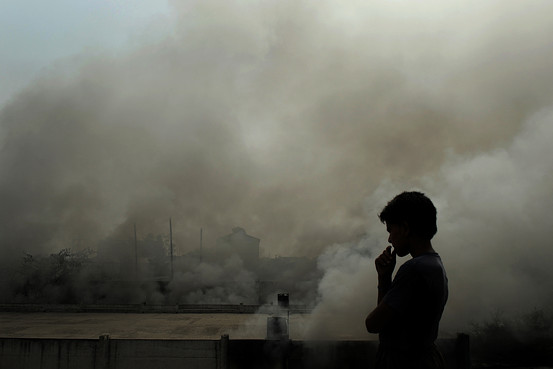 NEW DELHI — New Delhi’s air is the most polluted in the world, according to an international report that quantifies pollution levels, confirming findings by experts confounded by the lack of attention to the city’s problem.
NEW DELHI — New Delhi’s air is the most polluted in the world, according to an international report that quantifies pollution levels, confirming findings by experts confounded by the lack of attention to the city’s problem.
The findings by the World Health Organization, released on Wednesday, show that the cities ranking second through fourth are also in India, in the central Hindi belt.
For years, experts have wondered why so much international attention has focused on air pollution in Beijing when some say conditions are as bad or even worse in South Asia.
“I am shocked at the extent of the problem they found in India,” said Dr. Sundeep Salvi, the director of the Chest Research Foundation in Pune, India. “This is incredibly bad, and there is a complete lack of awareness about it both amongst policy makers and the common man.”
PM 2.5 refers to particulate matter less than 2.5 micrometers in diameter, which is believed to pose the greatest health risk because it penetrates deeply into lungs.
In Beijing, a pollution level as high as Delhi’s would most likely have caused widespread concern. But in Delhi, almost no one seemed to notice. Few people here wear the filter masks that have been appearing on the streets of Beijing, and even among the wealthy, few own air purifiers, which are used widely in East Asia, because few are even aware of the problem.
India is in the midst of national elections, but air pollution is rarely mentioned by leading politicians. At a recent embassy party here, several people expressed astonishment that New Delhi’s air was considered dangerous. One of the guests, a marathon runner who jogs through Delhi’s streets daily, said she had never noticed any problem with the air.
The W.H.O. report, which examined pollution levels in nearly 1,600 cities in 91 countries for the years 2008 to 2013, found that the annual mean for PM 2.5 concentrations in Delhi was 153 micrograms per cubic meter. The cities of Patna, Gwalior and Raipur followed Delhi for the worst air pollution readings. Delhi’s reading was almost three times that of Beijing, whose annual mean in the report was 59.
An article in The New York Times in January reporting that PM 2.5 levels in Delhi were at least twice as bad as Beijing’s led to weeks of pollution headlines in India’s largest newspapers and fierce denials by government officials.
Gufran Beig of India’s state-run System of Air Quality Weather Forecasting and Research said Thursday in an interview that the annual mean provided for Delhi in the W.H.O. report was incorrect.
“Our levels are comparable with those of other cities,” he said. “Delhi’s air quality is better than Beijing’s in summer and much better in monsoon season.”
A host of other officials, including the chairman of the Central Pollution Control Board, were either unavailable for comment on Thursday or said they were not authorized to speak publicly on the issue.
Air pollution killed about seven million people globally in 2012, making it the world’s biggest environmental health risk, the W.H.O. reported last month. About 80 percent of those deaths came from heart attacks and strokes, although air pollution also increases lung cancer deaths.
Dr. Carlos Dora, the coordinator of health and environment at the W.H.O., said most Asians should be concerned.
“The levels of air quality which we see in India, Pakistan, Iran and China are very worrying,” he said. “Air pollution has a huge impact on human health.”
The W.H.O. study found that in the cities that had provided data for a similar but smaller study in 2011, air quality had mostly deteriorated in the intervening years. The growing use of coal-fired power plants, cars and dung fuel for cooking is one of the principal causes of worsening air pollution, the organization said.
China’s extensive pollution problems have grown out of efforts by the country’s leaders to develop manufacturing and industrial capacity no matter the cost. But India has little to show for its toxic air. The country’s economy is sputtering, its small manufacturing sector has been shrinking, and efforts to build roads and open coal and metal mines have foundered on corruption and environmental concerns. Pakistan, which had three cities among the world’s 10 most polluted, has even less to show for its pollution levels, as economic growth there has been well below India’s for decades.
Dr. Anurag Agrawal, a pulmonary physician and researcher based in New Delhi, said he had seen a patient on Wednesday whose asthma had become so bad in recent years that he must take high doses of steroids to keep it under control. But when he leaves India, his symptoms disappear.
“So I told him that he should seriously consider changing the place he lived,” Dr. Agrawal said. “And he said he would not even consider moving.”








